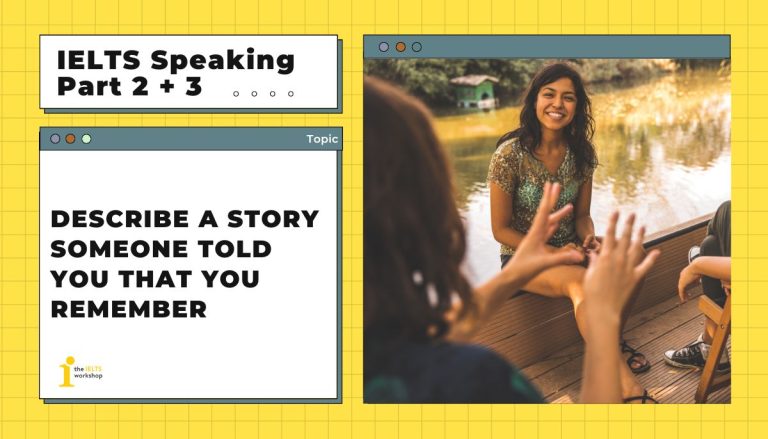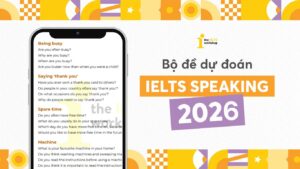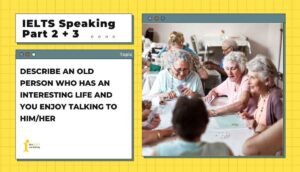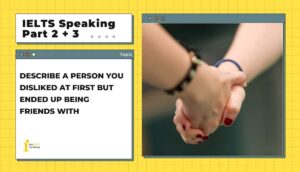Đến với chuyên mục giải đề kỳ này, thầy Đình Tân của The IELTS Workshop sẽ hướng dẫn bạn trả lời topic “Describe a story someone told you that you remember” trong IELTS Speaking Part 2. Cùng tham khảo sample, từ vựng và một vài cách diễn đạt ghi điểm trong phần thi IELTS Speaking nhé.
Part 2: Describe a story someone told you that you remember
Describe a story someone told you that you remember
You should say:
What the story was about
Who told you this story
Why you remember it
And how you feel about it
Dưới đây là bài mẫu cho topic “Describe a story someone told you that you remember“.
1. Bài mẫu (Sample)
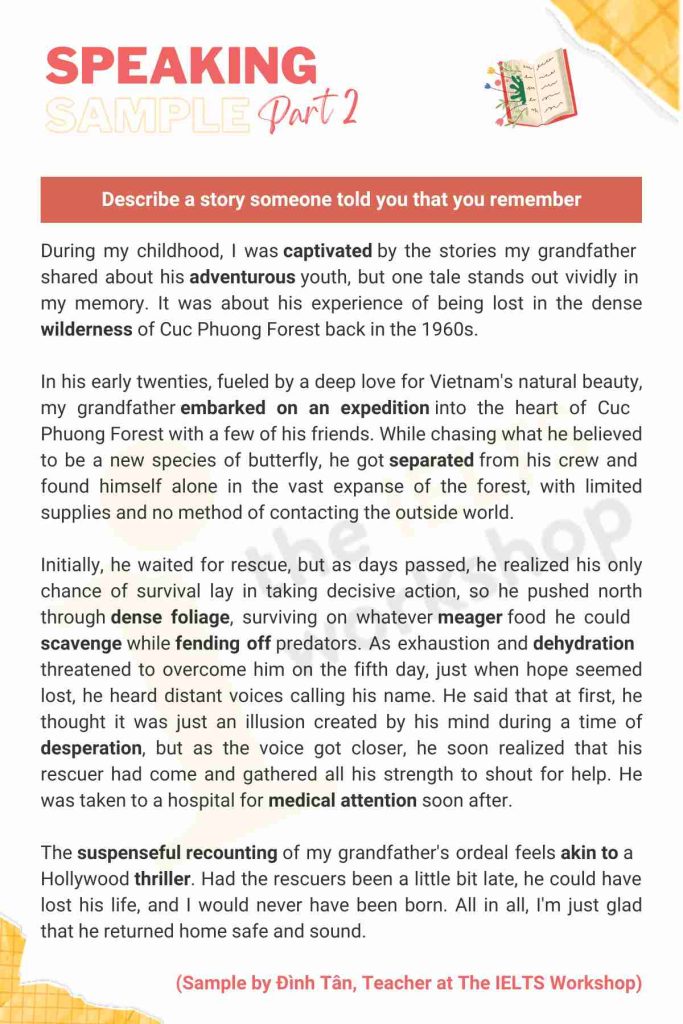
2. Từ vựng (Vocabulary)
- Captivate (v); Làm say đắm, thu hút, quyến rũ
- Adventurous (adj): Phiêu lưu, mạo hiểm
- Wilderness (n): Vùng hoang vu, vùng hoang dã
- Embark on an expedition / a journey: bắt đầu một chuyến thám hiểm / một chuyến hành trình
- Separate (v) tách rời ra
- Dense foliage: tán lá dày đặc
- To survive on sth: sống bằng cái gì
- Meager (adj): Ít ỏi
- Scavenge (v): Lượm nhặt
- To fend off sth / someone: Chống đỡ, đánh đuổi được cái gì / ai
- Dehydration (n) sự mất nước
- On the brink of: Trên bờ vực của
- Desperation: Sự tuyệt vọng
- Medical attention: (Sự) chăm sóc ý tế
- Suspenseful (adj): Hồi hộp
- Recounting (n) Sự kể lại
- Akin (adj) to sth: giống cái gì đó
- Thriller (n) Phim (sách, kịch) kịch tính, giật gân, hồi hộp
Part 3
Do young children like the same stories as older children?
How has technology changed storytelling?
Do you think children like technology more than storytelling?
What are the disadvantages of technological storytelling?
Do you think children should use technology for storytelling or listen to a real person’s story?
1. Do young children like the same stories as older children?
In the case of stories, children’s interests can vary depending on their age and individual preferences. Young children typically enjoy simple stories with clear illustrations and lovable characters. For example, they might like stories about animals or exciting adventures. However, as children grow older, they may want to read more complex stories with more details and depth. These stories often have a more mature nature, challenging and exploring the complexities of the world around them. For instance, fantasy novels, mysteries, or psychological thrillers might be popular choices.
- Individual preference: Sở thích cá nhân
- Illustration (n): Hình ảnh minh họa
- Lovable character: Đáng yêu
- Complex (adj): Phức tạp
2. How has technology changed storytelling?
Technology has profoundly transformed the way stories are told, offering both opportunities and challenges. One significant change is the accessibility and diversity of stories. With the rise of digital platforms and social media, stories can now be shared and consumed in various formats, such as videos, podcasts, and interactive apps. Consequently, children now have an abundance of stories at their fingertips, accessible with a mere click. However, there’s a concern that parents may rely solely on apps like YouTube or Spotify for telling children stories, potentially missing out on the personal touch of traditional storytelling.
- Profoundly (adv): Một cách sâu sắc
- Diversity (n): Sự đa dạng
- Accessibility (n): Khả năng tiếp cận
- An abundance of sth: Sự phong phú, sự nhiều sth
- To have sth at one’s fingertips: Có sẵn cái gì đó để sử dụng
3. Do you think children like technology more than storytelling?
Yes, I believe that the majority of children these days find technology more appealing than traditional storytelling. First, technology offers a diverse range of entertainment options, from movies and viral social media videos to interactive games, all of which can capture children’s attention for hours on end. Furthermore, unlike traditional storytelling, which may rely on the availability of parents or grandparents to tell stories, technology provides on-demand access to entertainment, allowing children to engage with content whenever they want.
- Appealing (adj): Lôi cuốn, cuốn hút, quyến rũ
- A range of sth: Một loạt cái gì đó
- Diverse (adj): Đa dạng
- To capture one’s attention: Thu hút sự chú ý của ai đó
- For hours on end: Hàng giờ liền
4. What are the disadvantages of technological storytelling?
While technology has transformed storytelling in many positive ways, it also presents several disadvantages. One significant disadvantage is the potential loss of human connection. In traditional forms of storytelling, such as face-to-face interactions or live performances, there is a direct and immediate connection between the storyteller and the audience. However, when stories are told through digital platforms, such as social media or streaming services, the personal interaction between the storyteller and the audience can be greatly diminished.
Moreover, the widespread accessibility of technology means that anyone with a smartphone and internet connection can become a storyteller, leading to an oversaturation of content and a dilution of quality. For instance, a simple search for a classic fairy tale like Snow White on YouTube yields myriad adaptations, ranging from faithful retellings to bizarre reinterpretations.
- Live performance: Biểu diễn trực tiếp
- Digital platform: Nền tảng kỹ thuật số
- Oversaturation: (n) Sự quá bão hòa
- Dilution: (n) Sự làm loãng, sự pha loãng, sự làm giảm bớt; sự làm mất chất
=> a dilution of quality: Sự suy giảm chất lượng - Myriad (adj): Rất nhiều, vô số
- Bizarre (adj): Kỳ quái, kỳ lạ, kỳ dị
5. Do you think children should use technology for storytelling or listen to a real person’s story?
Well, I believe both approaches to storytelling have their merits, but if I had to choose, I would lean towards children listening to real people’s stories. There’s something inherently valuable about the interaction and connection that comes from listening to a live storyteller. Not only does it foster a sense of intimacy and engagement, but it also allows children to experience the nuances of storytelling, such as voice inflections, facial expressions, and body language, which may not be fully captured through technology. Moreover, listening to real stories told by real people can help cultivate empathy and emotional intelligence in children as they learn to relate to the experiences and perspectives of others.
- Merit (n): Giá trị (tích cực)
- A sense of intimacy: Một cảm giác thân mật
- Nuance (n): Sắc thái
- Empathy (n): Sự đồng cảm
- Emotional intelligence: Trí tuệ cảm xúc
Bài mẫu bởi thầy Đình Tân – Giáo viên The IELTS Workshop
Trên đây là bài mẫu cho topic: Describe a story someone told you that you remember. Các bạn có thể tham khảo Tổng hợp bài mẫu IELTS Speaking Part 2 của The IELTS Workshop để có thể nâng cao kỹ năng Speaking của mình.
Ngoài ra, tham khảo khoá học Senior của The IELTS Workshop để có thể tìm hiểu thêm nhiều chiến lược làm bài khác của Speaking nhé.


